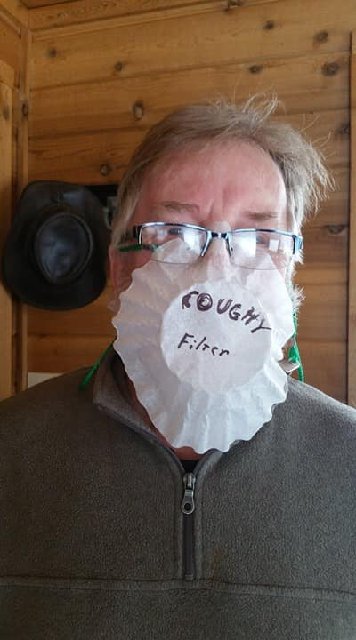I want a frowny face scarf
I want grumpy bunny...

Posted on 04/16/2020 6:05:07 AM PDT by real saxophonist
n April 3, after new data was released showing that up to a quarter of people infected with the coronavirus are asymptomatic, the CDC announced new recommendations for wearing face masks. Its guidelines stipulate that everyone should cover their faces with a cloth mask while “in public settings where other social distancing measures are difficult to maintain,” like the grocery store. This, of course, doesn’t mean we should rush to hoard the medical-grade masks desperately needed by health care workers. It means fashioning something yourself.
The CDC specifically recommends using tightly woven cotton to make a mask. So those of us who aren’t adept at sewing, or who have limited materials on hand, may be wondering whether the neck gaiters and bandanas we have sitting in our gear closets will do the trick instead.
Is a neck gaiter (most of which are roughly 95 percent polyester and 5 percent elastane), woven tightly enough for it to be beneficial? Is a bandana made from 100 percent cotton better? If not, what works best?
In short, the experts we spoke to agreed: something is probably better than nothing. But there are a few important caveats.
Synthetics Are Fine, but Cotton Is Better
Studies show that wearing any type of mask is likely to decrease exposure to the virus (the widespread use of masks during the 2003 SARS epidemic significantly reduced transmission). Paul Pottinger, an infectious-disease specialist at the University of Washington, explains that the main purpose of the CDC’s mask guidance is not just to protect ourselves but “to prevent people who are infected from spreading it to other people.” If we sneeze or cough, a simple homemade mask can stop our droplets from landing on surfaces or other people. Can masks also protect us from ingesting other peoples’ droplets? “Yes, although that’s a secondary concern,” says Pottinger. “And frankly, it’s a lot easier to prevent yourself from shedding to others than it is to prevent yourself from acquiring from others.”
According to Pottinger, anything that reduces droplets from leaving your mouth or nose is perfectly fine. In other words: a neck tube is better than nothing. But in the limited studies that have been done, data has shown that when it comes to stopping incoming germs, there is a hierarchy of what’s potentially best.
Cotton is better than a synthetic material. Fashioning a mask out of a bandana or T-shirt made of 100 percent cotton, like the one shown in this video, is better than a stretchy synthetic neck gaiter. Experts say that polyester and spandex (what most gaiters are usually made of) retain germs longer.
Tightly woven fabrics are best. A tight weave like you’d find in a tea towel, bandana, high-thread-count pillowcase, thick flannel pajamas, or a vacuum bag, is better than, say, a scarf, which tends to be more loosely woven and susceptible to letting droplets in. If you’re trying to decide whether the fabric you’re looking at is going to work well for a mask, Pottinger suggests holding it up to the light. “If you can see light coming through right away, it’s not an ideal fabric,” he says. “It’s still probably better than nothing, but I would then want to get more than one layer of that material involved.” One neck gaiter might be see-through, for example, but two worn together would be a little better.
Double up. Regardless of the material, doubling or even quadrupling fabric into layers appears to increase your protection significantly. The New York Times reported data from a study led by Dr. Yang Wang at the Missouri University of Science and Technology whose team found that a 600-count pillowcase captured 60 percent of particles when folded into four layers, compared to only 22 percent when doubled. (A bandana captured only 19.2 percent of particles, even with four layers.) At the same time, don’t forget that your mask should also allow you to breathe comfortably, says Pottinger.
There’s a Right and a Wrong Way to Wear a Mask
“Something I see a lot is people wearing it just over their mouth and not their nose, and that kind of defeats the purpose,” says Sarah Doernberg, an infectious-disease specialist at the University of California at San Francisco. It needs to cover both your mouth and nose.
Once it’s on your face, don’t touch it. Fiddling with the mask will cause contamination. “Wash your hands before putting it on,” Doernberg says, “and never touch the part where your mouth goes. Only touch the straps. Wash your hands afterward as well.”
No matter what kind of cloth mask you use, when you get home, it should come off. “The [outer] surface of that face covering should be considered contaminated. Don’t touch it,” says Pottinger. “If you do, no sweat, just wash your hands.” You should also launder the mask after each use.
Masks Alone Aren’t Enough
Masks are just one component of a broad set of guidelines for protecting ourselves and others. Social distancing should remain everyone’s first course of action, says Doernberg. Masks are “kind of a supplement,” she says. Health professionals like Doernberg and Pottinger have expressed concern that masks will give people the false sense of security that it’s OK to hang out with friends or get closer than six feet to people. Perhaps, though, Doernberg says, masks will serve as a reminder to give others a wide berth and keep up our hygiene practices.
I have a selection of similar masks in various Mossy Oak patterns. It’s great fun at the grocery store.
L
They should rate them on halitosis too.
The problem with some of these tightly woven masks is that CO2 you exhale gets trapped in the mask and you breathe it in, resulting in lower oxygen intake (hypoxia) causing damage to your heart and brain.
I want a frowny face scarf
I want grumpy bunny...

If the cloth masks are worthless against viruses; I don't see any reason to use them to prevent transmission of viruses.
The "experts" who say it stops the spreading of this virus to others evidently don't understand how small this virus is. Breathing through a cloth mask is like breathing through your screen door to the virus.
What the cloth masks do is give some people the illusion they are doing something. They aren't but it gives them some feeling in control. It's a placebo. I can say for those who take comfort using them are probably spreading the virus faster which isn't such a bad thing because the spread is inevitable but mental well being is important too so in that one way the cloth masks do something positive.
Like this?

Or this?

Seriously; more layers will help. I'm just not sure stopping this virus is even possible. It wasn't with the H1N1. That virus ended when it had run its course when no one in America did anything like wearing masks.
I do think people like to think they are doing 'something'.
Your link doesn’t match the article. Would you please provide the correct link to the article about cotton face masks?
The other article at your link—about companies donating to the cause—is very worthy and deserves its own thread and headline on FR.
Here is the proper link: https://www.outsideonline.com/2411426/buff-bandana-face-mask-effectiveness
Admin, could you fix this please?
Thanks to both. Some kind of weird cut-and-paste thing...
A four-year long study published in JAMA established that surgical masks are just as effective at preventing Influenza A and B as N95 masks.
https://jamanetwork.com/journals/jama/fullarticle/2749214

Of course it’s not ideal. It’s a statistical mitigation.
Disclaimer: Opinions posted on Free Republic are those of the individual posters and do not necessarily represent the opinion of Free Republic or its management. All materials posted herein are protected by copyright law and the exemption for fair use of copyrighted works.